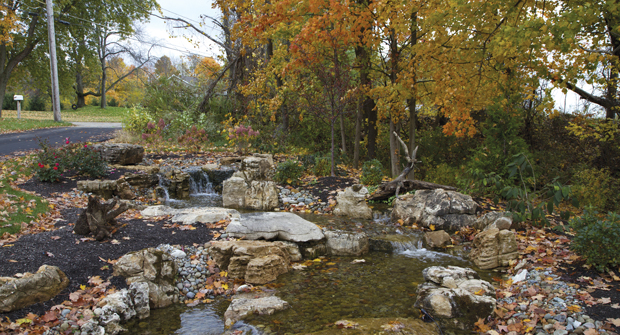Tyler Fisher, Northeast regional sales manager for Atlantic-Oase based in Aurora, Ohio, says an old tagline he’d heard from his CEO was “life is better living in water.” He’s sometimes surprised many landscapers and clients often overlook the value water features can add to a property.
“Sometimes you can have somebody out there and say, ‘Hey, close your eyes. Imagine there’s water running.’ Or you can have the sound of it going, and that’s sometimes enough to seal the deal for somebody,” he says. “It’s something to have in your toolkit that is a really good upsell.”
One of the main disincentives with water features, especially the farther north you go, is that the process of preparing them for winter can be tricky, meaning landscapers should be well-versed in the topic if they want to utilize effective water features.
Don’t fall short
As most things in the industry go, preparation starts early, and landscapers should be thinking about winterization for their water features in the fall. Fisher recommends preparing for winter by keeping water features clean during the warm season. Plus, treating larger water features with aeration and regular applications of sludge-consuming bacteria to reduce organics is another important step.
Using pond netting to intercept leaves before winter arrives is another great technique for smaller features. For pondless features and fountains with water stored in an underground basin, Fisher says it’s best to clean out any organics in the fall, then remove the pump and check valve before cleaning and servicing them if needed before storing them inside for the winter.
Freezing over
While smaller features may be allowed to freeze right over, Fisher says anything with fish in it requires some extra steps.
“When it comes to a big pond, you can put filtration on there, you can put a plethora of things to clean it out —treatments — but you’re still dealing with an ecosystem,” Fisher says.
Many of the bigger features like ponds, waterfalls and other open bodies of water already need extra attention, and when it comes to caring for fish, Fisher points out that they need to be able to breathe under the ice. If possible, cleaning ponds in the fall reduces the organics that would eat up the oxygen over the winter.
To further ensure a good supply of oxygen for the fish, Fisher recommends placing an aerator in the shallows to keep a hole free of ice, leaving the deepest, warmest water undisturbed.
Set for success
Not every water feature needs the same kind of preparation, and with all the options out there, Fisher says finding a solution that fits your feature is key.
“Staying consistent is a big part of it,” he says. “If you did one thing the first winter and it worked, do it again the next winter.”
Plus, as winters in places like Ohio seem to get tamer each year, it’s important for landscapers to attack the problems early instead of assuming the cold season will get easier or cause less problems.
“Maybe it wasn’t an issue last winter, but it could be an issue this winter, so definitely be prepared,” Fisher says. “Everything you’re doing now is setting you up for what you have to deal with in the spring.”


